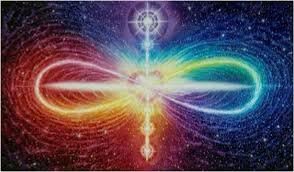Research at the HeartMath institute suggests that the heart is “an access point to a source of wisdom and intelligence that we can call upon to live our lives with more balance, greater creativity and enhanced intuitive capacities. All of these are important for increasing personal effectiveness, improving health and relationships and achieving greater fulfillment.” I first heard about the institute fifteen years ago when I was publishing a wellness lifestyle magazine and met Gregg Braaden, New York Times best-selling author and scientist who is best known for bridging science, spirituality and the real world.

Although yoga is not a religion, it is a spiritual practice. One of my main goals of living yoga is to raise the energy of my spiritual self. I define that as cultivating a life where my frame of reference comes from my heart. The Yoga Sutras tell us that yoga stills the fluctuations of the mind and my belief is the value of that calm and balance moves actions and behaviors from your head to your heart. If we practice yoga I believe we cultivate heart intelligence.

I met Mr. Braaden at a conference where he explained how there is a scientifically proven energy field that extends out from us. He showed us via live visual tools that the heart is surrounded by a field of energy that extends out about five to eight feet (and possibly farther, but there were no tools to measure this at the time). This heart field extends on the physical and quantum level.
As I sat in a large auditorium in a packed room of people he showed us how we all may be separate but you are sharing a “heart field”. As a random participant sat in the front of the room Braaden connected them to a monitor where we viewed the energy field of the brain through various colors. He informed us that we could witness the signal from the heart to the brain. The quality of that signal is called coherence. If we can create an optimal feeling in our hearts, it affects our brain.
He then instructed us to close our eyes. I thought he would ask us to think positive things about this person hooked up to a monitor at the front of the room. At the time, there had been a lot written about sending “good thoughts” long distance for an intended recipients healing. Instead, he asked us to each think of something WE were grateful for. As we did this, the subject’s brain waves at the front of the room – based on OUR energy – changed. Positively. I was in awe of the transformational powers that my heart, that our hearts, had on a total stranger.

It gave me great confirmation of the wisdom my grandmother used to tell me to be of “be careful of whom you surround yourself with.” I had scientific proof for myself that my heart felt gratitude could affect not only myself but others. I wanted to learn more so that I could integrate this wisdom with my yoga practice. I had always known that yoga was an ancient science but I am now fascinated with the idea that group heart centered practice can heal the world. Science is bearing out that if we can marry the wisdom of the past with the science of our time with the spiritual traditions we can deal with the challenges in the world today.
I encourage you to consider the quality between the heart and the brain the next time you practice. In addition to practicing heart opening postures, research and find a Bhakti yoga teacher if you have not tried it. The Sanskrit word bhakti comes from the root bhaj, which means “to adore or worship God.” Bhakti yoga has been called “love for love’s sake” and “union through love and devotion.” Bhakti yoga, like any other form of yoga, is a path to self-realization, to having an experience of oneness with everything.
Bhakti Yoga complements other paths of yoga well, and it is said that jnana (knowledge or wisdom) will dawn by itself when you engage in the devotional practices of Bhakti Yoga. The ultimate goal in the practice of Bhakti yoga is to reach the state of rasa (essence), a feeling of pure bliss achieved in the devotional surrender to the Divine.
I have practiced with a Bhakti teacher at a workshop (Mas Vidal) but I don’t regularly practice with a Bhakti teacher. Instead, I take the essence of the practice and apply it to my own by:
- Beginning a heart-centered practice by journaling what I am grateful for
- Lighting a candle to express my wish that all beings be free from suffering; while chanting the mantra Om Mani Pad Me Hum –
Om (ohm)- Om is the sound or “vibration” of the universe. This sound is the most important of all; but in the context of chanting and mantras, it is meant destroy attachments to ego and establish generosity.
Ma (mah)- Removes the attachment to jealousy and establishes ethics.
Ni (nee)- Removes the attachment to desire and establishes patience.
Pad (pahd)- Removes the attachment to prejudice and establishes perseverance.
Me (meh)- Removes the attachment to possessiveness and establishes concentration.
Hum (hum)- Removes the attachment to hatred and establishes wisdom.

Yogis are the most open to learning how to live a heart-centered life, so I hope the above Buddhist chant and information help you on your ongoing yoga journey. If you can shift your energy from your head to your heart, I believe your life – and the lives of those around you – will be enhanced.
For more information: Gregg Braaden (greggbraden.com) and the HeartMath Institute (heartmath.org)
Article by Yoga Guide contributor writer: Stephanie Spence










Recent Comments